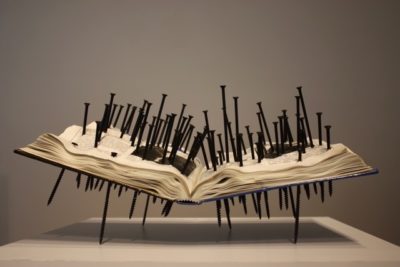Changed Climate, Detail, Nature and ecology books, screws, soundtrack
Kennedy © 2018
Also included in Nature Speaks: Listening Together was an installation, Changed Climate. The books in this artwork, now violently rendered inaccessible, contain images of a thriving natural world now either gone or damaged, and vital scientific information. Ecological challenges explored in these books include rising rates of species extinctions, ocean acidification, the death of coral reefs, forest mortality, pollution of our air and water, as well as an increasingly unstable climate.
Climate change, our most pressing problem, is accelerating many of these environmental challenges, and is starting to threaten the stability of our societies as food and water
become more expensive and scarce. To ensure a healthy future for ourselves, our children, and the natural world, we must be guided by good science and transform our lives and societies to support the health of all people and the biosphere.
My treatment of these books was done with a grave heart and with a clear memory of the repeated ill treatment of books at home and abroad. This “sinning in the name of art” is an attempt to rouse our sleeping consciousnesses. I subjected my own book to this furious transformation.

Changed Climate, Detail, Nature and ecology books, screws, soundtrack
Kennedy © 2018
